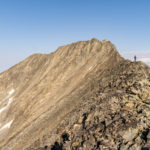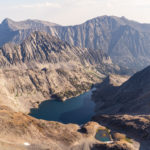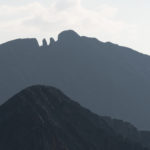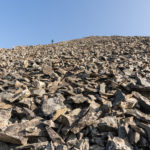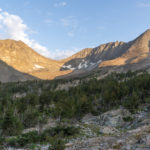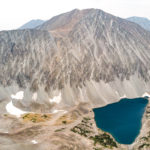
Iddings Peak - Second tallest peak in the Crazy Mountains
The Crazy Mountains are a relatively unknown and isolated mountain range in Montana. They are hard to access because there is a checkerboard of private land throughout the entire range. The mountains themselves are pristine wilderness at its finest and the peaks are as rugged as anything you'll find in Montana. Iddings Peak is the second tallest peak in the Crazies at 10,936 feet. Crazy Peak is the tallest at 11,209 feet, but it is climbed much more often than Iddings. Both are very difficult and potentially dangerous climbs. Since Iddings is lesser-known and not traveled as often the level of adventure to be found here is even higher.
Difficulty Rating: Hard
Stats
The route will take you through the Grand Teton National Park, but if you time it right you can camp outside of the park every night, so permits are not necessary.
Interactive map
Getting to Iddings Peak
You'll be parking at the Rock Creek North trailhead in the Custer Gallatin National Forest. From Clyde Park, MT head east on Rock Creek Road. Take a left on Robinson Bench Road, then another left on Little Rock Creek Road where you will find the trailhead.
The Route
Summary: The approach is about 9 miles to get you to Smeller Lake which is at the base of Iddings Peak. Then it's off-trail rock scrambling from there.
You'll be starting out in about 3.3 miles of private property. The Rock Trail is a national forest trail and you are allowed to hike through here, there will be signs telling you to stay on the trail though. After 1.5 miles you'll reach a road that you will follow for another 2.3 miles. When you see a National Forest sign that says Rock Creek Trail, leave the road to follow the trail. Then it's nice forest walking for the next 3.4 miles. When you reach the junction with the Smeller Lake trail leave the Rock Creek trail and head east to Smeller Lake. After some climbing, you'll be in a small open valley with a really nice waterfall, the Smeller Creek Falls. Continue climbing into a more alpine environment. As you get close to Smeller Lake the trail may become hard to follow. Just keep going uphill and follow the creek to the lake.
Climbing Iddings Peak
Now you'll be off-trail the rest of the way. Iddings Peak is the prominent peak to the northwest. Start by climbing the huge scree-covered hill that comes down to the northwest corner of Smeller Lake. This will be a steep and tedious climb to get up to the ridge. Once you reach the ridge it's a straight shot to Iddings Peak. The ridge will be a treacherous knife-edge though. Take your time and pick your way through the ridge-line. There will be some class 3 or 4 climbs in there, where you will need to climb with hands and feet. At times the ridge will be no wider than a couple of feet with sheer drops on either side. Make sure you pick a good weather window to do this, even high winds could be very dangerous. We didn't use any ropes or climbing gear though. Once on top enjoy the view! Just remember that getting up there is only half the challenge. You'll want to allow another 2-3 hours to get back down, so keep that in mind if there is some weather approaching.
Best time to hike
Late July through Mid-September. The Crazies seem to hold snow longer than surrounding mountain ranges, so you'll want to allow plenty of time for the snow to melt. We hiked it at the end of August and that was perfect timing. Picking a clear weather window is extremely important for this hike. Obviously, you want to avoid storms, but wind can be a problem too. The Crazies also seem to be one of the windiest places in the area and you'll have to gauge that danger while you climb.
What to bring
Even in the middle of summer, you can expect temperatures to drop into the 40's or lower at night. During the day it may reach into the 90's.

